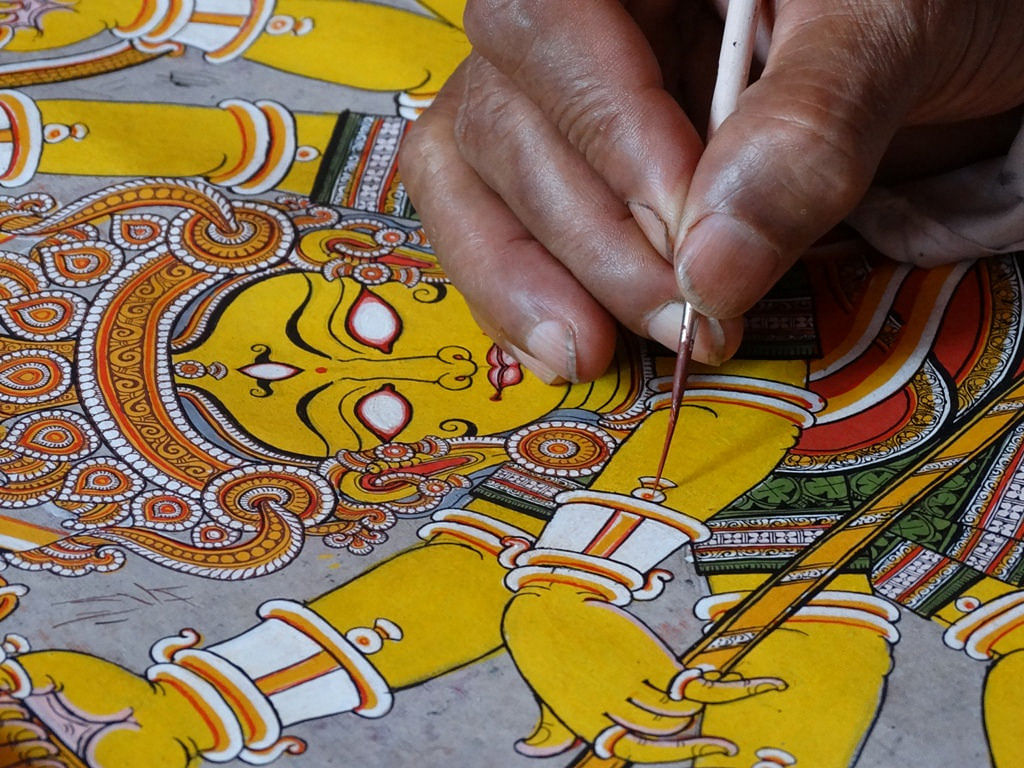
On the banks of River Bhargavi, not too far from Puri, lies a village called Raghurajpur. It is inhabited by some of the greatest artists of patachitra, with entire families devoted to the pursuit of the art. Today, the place bears the title of ‘Heritage Village’, due to its contribution to a special form of art, which is as ancient as history itself. According to some people, patachitra is one of the oldest indigenous art forms of Odisha.
Vibrant colours, intricate lines and imaginative figurines are intrinsic to patachitra, the word being a combination of two words ‘pata’ and ‘chitra’. It is said that patachitra, which dates back to the 12th century, reflects the painting style that has been found in the ancient cave paintings of Udaygiri, Khandagiri and Sitabhinji.
The master artists, known as chitrakars, mostly belong to the Mahapatra, Maharana, Sahoo or Swain communities, with the skills being passed through generations.
According to our guide, the origin of the art form lies the famous Jagannath Temple of Puri, which was built by Chodaganga Deva, the ruler of Kalinga, in the 12th century. Originally created on a canvas of cloth, patachitra has ritualistic importance in the temple. During the Rath Yatra, when the idols of Lord Jagannath, Balabhadra and Subhadra are taken out in the procession, patachitra of the idols is placed in the sanctum sanctorum.
The life of the residents of Raghurajpura revolves around patachitra. The process is laborious and elaborate. While the women are involved in the preparation of the pigments and the making of canvases, the men folk busy themselves in the process of painting.
Making a canvas is a process in which the cotton cloth is placed in a solution of tamarind seeds and water for about five days. Thereafter, a paste of chalk powder and gum is applied on the cloth, and it is smoothened out before being dried in the sun. This is followed by a series of steps in which the cloth is rubbed with different kinds of stones to give it gloss and smoothness.
Traditionally, five colours, based on the mythological texts, were used in paintings. For instance, Krishna is always painted in blue, while yellow is used for Radha, green for Rama, and white for Balabhadra. The pigments are made from various organic substances. The yellow comes from a stone known as haritala, the red from geru, black from the soot that comes from the burning of coconut shell, blue from indigo, and the white from powdered conch shells. Now, young artists use fabric paints.
Once the canvas and pigments are ready, an outline is drawn. Traditionally, lamp-soot-mixed rice paste, rolled into sticks, was used to draw the outline, but now, many artisans have replaced the method with chalk or pencil. One of the most distinctive features of patachitra is the multiplicity of elaborate borders that provide a distinctive frame for the painting. The motifs have largely been derived from the sculptures of the local temples of Odisha. The border is one of the most important and creative aspects of patachitra. Vibrant colours and fine designs are used to create the beautiful border, which is drawn with a fine set of mouse-hair brushes. The outer border is broader and made of floral motif, while the narrower inner border consists of a variation of the leaves blended with geometrical motif.
The faces in the paintings have exaggerated eyes, pronounced chins and long beak-like noses. The characters are individualised by the use of diverse facial features, hairstyles and clothing. A combination of utmost skill, patience and diligence is necessary for painting a patachitra. At the end of the laborious work emerges the iconic paintings, each one of them telling a story.